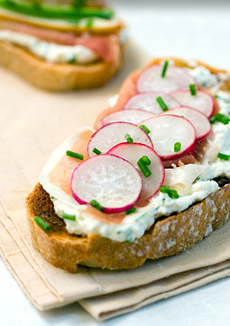|
Layering is trending as a light and refreshing approach that makes you want to eat more salad. The contrast of different colored vegetables (and fruits) makes the food all the more tempting.
This recipe is by Zac Benedict for the California Avocado Commission.
This recipe (below) uses 12-ounce mason jars, a main-dish size salad for each person. You can also use 16.5-ounce mason jars. The handled jars can be used for food or drinks.
If you don’t want to buy mason jars, check to see what you already have; for example, glass dessert bowls or jumbo wine goblets. Use smaller jars for a side salad. Zac suggests collecting large baby food jars, and for the larger mason jars use chopsticks, which easily reach the bottom of the jar.
The idea is to eat the layered salad from the jar, although Zac advises that you can also set out serving bowls for people who want to toss their salads.
In addition to Recipe #1, a second recipe for Seven Layer Salad is below
COLORED PRODUCE: FRUIT & VEGETABLE OPTIONS
Select vegetables in a variety of colors. For example, if you like scallions but have too much green, substitute red onion. If you’re using red tomatoes, use orange and yellow bell peppers instead of red ones.
Green Fruits & Vegetables: broccoli, edamame (soybeans), herbs (basil, cilantro, dill, parsley), green beans, green peas (frozen are fine), mesclun or other salad greens, snow peas, spring peas, sugar snap peas
Orange Fruits & Vegetables: bell pepper strips, carrots (baby carrots, sliced or shaved carrots), cherry tomatoes, heirloom tomatoes, kumquats, grape tomatoes, mandarin wedges, mango, sweet potatoes (cubed or sliced)
Purple Fruits & Vegetables: cauliflower, grapes, heirloom tomatoes, kale, Peruvian potatoes, red cabbage, purple raisins (you can plump them in cider)
Red Fruits & Vegetables: beets, bell pepper strips, cherry tomatoes, dried cherries or cranberries, grape tomatoes, lady apples, mini red jacket potatoes, pomegranate arils, radicchio, radishes, red grapes/champagne grapes, red onion, sundried tomatoes, tomatoes
Yellow Fruits & Vegetables: artichoke hearts, bell pepper strips, cherry tomatoes, heirloom tomatoes, lemon peel, miniature pattypan squash, star fruit (carambola), yellow squash
White Fruits & Vegetables: cauliflower, cucumbers, daikon, Granny Smith apples, grapes, mushrooms, water chestnuts, zucchini
You can also add diced meats and cheeses, cooked grains, beans and legumes; plus condiments such as olives and sliced pickles.
RECIPE #1: YOUR OWN LAYERED SALAD
Ingredients
Choose whatever ingredients you want, from the list above or from browsing the market. Select your dressing. Then, prepare!
The recipe for the Dijon citrus vinaigrette follows.
Preparation
1. LAY out the rinsed, dried, and cut produce ingredients.
2. PLACE the heaviest ingredients on the bottom of the jar (or bowl), and the most crushable items at the top.
Try to be as even as possible: The layers don’t have to be perfect but they look very nice when the ingredients are in neat rows.
|
|

[1] Is there a prettier salad? (photo © California Avocado Commission).

[2] Vegetables in the colors of the rainbow brighten your salad (photo © Good Eggs).

Prepare the ingredients; then, it’s easy to layer (photo © California Avocado Commission).
|









